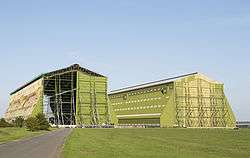Airship hangar
Airship hangars are specialized buildings that are used for sheltering airships during construction, maintenance and storage. Rigid airships always needed to be based in airship hangars because weathering was a serious risk.
History
Early hangars

The first real airship hangar was built as Hangar “Y” at Chalais Meudon near Paris in 1879 where the engineers Charles Renard and Arthur Constantin Krebs constructed their first airship “La France”. Hangar “Y” is one of the few remaining airship hangars in Europe.
The construction of the first operational rigid airship LZ1 by Count Ferdinand von Zeppelin started in 1899 in a floating hangar on Lake Constance at Manzell today part of Friedrichshafen. The floating hangar turned into the direction of the wind on its own and so it was easier to move the airship into the hangar exactly against the wind.
For the same reason later rotating hangars were built at Biesdorf (today part of Berlin) and at the Nordholz Airbase, to the south of Cuxhaven in Germany. Already before the First World War there were transportable tent constructions as hangars for smaller airships. They were quite common in the US at fairgrounds or exhibitions. The American Melvin Vaniman constructed big tent hangars in France particularly for the French army.
The Zeppelin programme
With the construction of Zeppelin LZ1 the era of big rigid airships started in Germany and for this very big airship hangars were necessary. This development started at the Zeppelin plant in Friedrichshafen before the First World War, continued through the war with dozens of hangars for construction of big rigid airships and their operation all over Germany and the occupied territories. In the 1920s and 30's even bigger hangars for the new LZ 129 Hindenburg class airships were built at Friedrichshafen, Frankfurt and at Bartolomeu de Gusmão Airport, Santa Cruz, Rio de Janeiro, Brazil, the only Zeppelin airship hangar of all those built which still exists[1]
UK airship construction

Also in the UK there was a rigid airship program during the First World War. This required the big construction sheds in Barrow-in-Furness, Inchinnan, Barlow and Cardington and the rigid airship war stations at Longside, East Fortune, Howden, Pulham (Norfolk) and Kingsnorth.

Today, only the two imposing Hangars of the former Royal Airship Works, in Cardington, Bedfordshire remain, where the R101 was built. The No.1 Cardington hangar is original, but extended; the No.2 hangar was relocated to Cardington from Pulham in 1928.[2]
In 1924, the Imperial Airship Communications scheme planned to extend mail and passenger service to British India, so an 859-foot hangar was constructed at Karachi (now in Pakistan) in 1929. This was the intended destination of the R101.[3]
France
In France few big hangars had been built, because with the “Spies” there was only one attempt to build a rigid airship. Nevertheless, at the end of the First World War an airship station for rigid airships was built in Cuers-Pierrefeu by adding the parts of smaller hangars to two big ones.
At Paris-Orly Airport two concrete hangars were built between 1923 and 1926. Planned by the famous engineer Eugene Freyssinet, the 300 metre-long buildings were an important innovation according construction and aesthetic of the design. None of the big French hangars exist anymore, while a few smaller ones still are there.
The USA


In the USA big hangars started in 1921 with Hangar No 1 at Lakehurst Naval Airship Station (NAS). Additional hangars, which housed the USS Akron (ZRS-4) and USS Macon (ZRS-5), exist in Akron, Ohio (the Goodyear Airdock, 1929) and Sunnyvale, California (Hangar One, Moffett Federal Airfield, 1932). The ships were constructed in Akron. The Akron was based in Lakehurst while the Macon was based at Moffett Field. During World War II, seventeen large hangars were built to house US Navy blimps. Today, seven of these wooden hangars still exist: Moffett Field (2), Tustin, California (2), Tillamook, Oregon (1), and Lakehurst, New Jersey (2).
Post World War hangars

After the Second World War worldwide only one big airship shed had been built: The one in Brand south of Berlin for the construction of the Cargolifter AG airship. With a length of 360m, a width of 210m and a height of 107m it is one of the largest unsupported structures in the world. After the bankruptcy of Cargolifter AG it was converted into the leisure center “Tropical Islands”.
For the needs of the rather small blimps quite a number of mostly simple hangars exist around the world today.
References
Notes
- ↑ Zeppelin Hangar
- ↑ Bowyer (1983): Pp 94-100.
- ↑ http://pakistaniat.com/2010/12/08/the-airship-hangar-in-pakistan
Bibliography
- Bowyer, Michael J.F. (1983). Action Stations, Volume 6, Military airfields of the Cotswolds and the Central Midlands. Cambridge: Patrick Stephens. ISBN 0-85059-529-0.
Further reading
- Manfred Bauer: Luftschiffhallen in Friedrichshafen. Friedrichshafen 1985
- Kim Braun: Die Luftschiffhäfen Niedersachsens in Der Traum vom Fliegen. Oldenburg 2000
- Hein Carsens: Schiffe am Himmel - Nordholz-Geschichte eines Luftschiffhafens. Bremerhaven 1997
- Christopher Dean: Housing the Airship. London 1989
- Lassalle Maryse: Bases pour dirigeables. Aix-en-Provence, France 2005
- John Provan: The German Airship Sheds. Kelkheim 1988
- John Provan: Luftschiffhafen Rhein-Main. Kelkheim 1986
- John Provan: Die französischen Luftschiffhallen. Kelkheim 1989
- James R. Schock: American Airship Bases and Facilities Edgewater. Florida, USA 1996
- Dr. Fritz Strahlmann: Zwei deutsche Luftschiffhäfen des Weltkrieges - Ahlhorn und Wildeshausen. Oldenburg 1926
- Michael Wulf: Luftschiffhallen, Dissertation, Technische Universität Carola-Wilhelmina. Braunschweig 1997
External links
| Wikimedia Commons has media related to Airship hangars. |
- (French) Le Hangar à Dirigeables d'Ecausseville
- Hangar of Shanghai Vantage Airship Manufacture Company Limited China
- Hangar Team Augusta Italy
- The Airship Heritage Trust Cardington UK
- Navy Lakehurst Historical Society USA
- Cuers-Pierrefeu Airdrome, Cuers, France
- "Dirigible Hangar Rotates To Reduce Wing Peril" Popular Science, May 1935, futuristic idea on dirigible hangars for airline service
